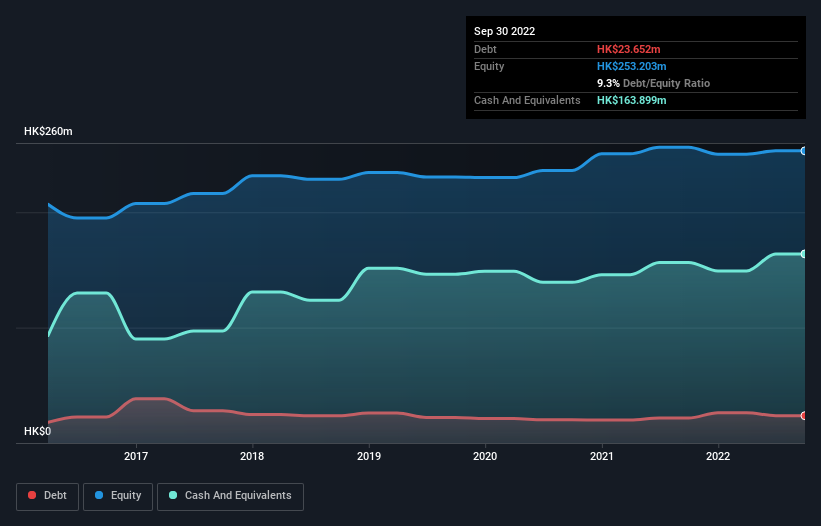Some say volatility, rather than debt, is the best way to think about risk as an investor, but Warren Buffett famously said that 'Volatility is far from synonymous with risk.' So it seems the smart money knows that debt - which is usually involved in bankruptcies - is a very important factor, when you assess how risky a company is. We note that eprint Group Limited (HKG:1884) does have debt on its balance sheet. But is this debt a concern to shareholders?
Why Does Debt Bring Risk?
Debt and other liabilities become risky for a business when it cannot easily fulfill those obligations, either with free cash flow or by raising capital at an attractive price. Part and parcel of capitalism is the process of 'creative destruction' where failed businesses are mercilessly liquidated by their bankers. However, a more common (but still painful) scenario is that it has to raise new equity capital at a low price, thus permanently diluting shareholders. Having said that, the most common situation is where a company manages its debt reasonably well - and to its own advantage. When we examine debt levels, we first consider both cash and debt levels, together.
View our latest analysis for eprint Group
How Much Debt Does eprint Group Carry?
As you can see below, at the end of September 2022, eprint Group had HK$23.7m of debt, up from HK$21.6m a year ago. Click the image for more detail. But on the other hand it also has HK$163.9m in cash, leading to a HK$140.2m net cash position.

How Healthy Is eprint Group's Balance Sheet?
Zooming in on the latest balance sheet data, we can see that eprint Group had liabilities of HK$94.4m due within 12 months and liabilities of HK$13.3m due beyond that. Offsetting these obligations, it had cash of HK$163.9m as well as receivables valued at HK$8.26m due within 12 months. So it actually has HK$64.5m more liquid assets than total liabilities.
This excess liquidity suggests that eprint Group is taking a careful approach to debt. Given it has easily adequate short term liquidity, we don't think it will have any issues with its lenders. Simply put, the fact that eprint Group has more cash than debt is arguably a good indication that it can manage its debt safely.
The modesty of its debt load may become crucial for eprint Group if management cannot prevent a repeat of the 42% cut to EBIT over the last year. When it comes to paying off debt, falling earnings are no more useful than sugary sodas are for your health. When analysing debt levels, the balance sheet is the obvious place to start. But you can't view debt in total isolation; since eprint Group will need earnings to service that debt. So if you're keen to discover more about its earnings, it might be worth checking out this graph of its long term earnings trend.
Finally, while the tax-man may adore accounting profits, lenders only accept cold hard cash. While eprint Group has net cash on its balance sheet, it's still worth taking a look at its ability to convert earnings before interest and tax (EBIT) to free cash flow, to help us understand how quickly it is building (or eroding) that cash balance. Happily for any shareholders, eprint Group actually produced more free cash flow than EBIT over the last three years. That sort of strong cash generation warms our hearts like a puppy in a bumblebee suit.
Summing Up
While we empathize with investors who find debt concerning, you should keep in mind that eprint Group has net cash of HK$140.2m, as well as more liquid assets than liabilities. The cherry on top was that in converted 299% of that EBIT to free cash flow, bringing in HK$40m. So we don't think eprint Group's use of debt is risky. The balance sheet is clearly the area to focus on when you are analysing debt. But ultimately, every company can contain risks that exist outside of the balance sheet. We've identified 3 warning signs with eprint Group (at least 2 which are a bit unpleasant) , and understanding them should be part of your investment process.
If you're interested in investing in businesses that can grow profits without the burden of debt, then check out this free list of growing businesses that have net cash on the balance sheet.
New: Manage All Your Stock Portfolios in One Place
We've created the ultimate portfolio companion for stock investors, and it's free.
• Connect an unlimited number of Portfolios and see your total in one currency
• Be alerted to new Warning Signs or Risks via email or mobile
• Track the Fair Value of your stocks
Have feedback on this article? Concerned about the content? Get in touch with us directly. Alternatively, email editorial-team (at) simplywallst.com.
This article by Simply Wall St is general in nature. We provide commentary based on historical data and analyst forecasts only using an unbiased methodology and our articles are not intended to be financial advice. It does not constitute a recommendation to buy or sell any stock, and does not take account of your objectives, or your financial situation. We aim to bring you long-term focused analysis driven by fundamental data. Note that our analysis may not factor in the latest price-sensitive company announcements or qualitative material. Simply Wall St has no position in any stocks mentioned.
About SEHK:1884
eprint Group
An investment holding company, provides printing services and solutions on advertisements, bound books, stationeries, and yacht financing in Hong Kong.
Mediocre balance sheet and slightly overvalued.
Market Insights
Community Narratives




